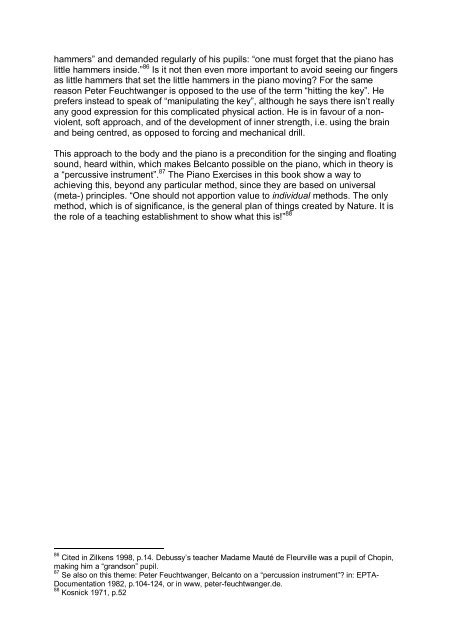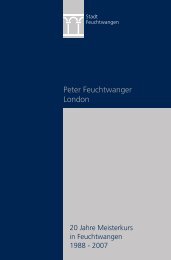Zen in the art of playing the piano - Peter Feuchtwanger
Zen in the art of playing the piano - Peter Feuchtwanger
Zen in the art of playing the piano - Peter Feuchtwanger
You also want an ePaper? Increase the reach of your titles
YUMPU automatically turns print PDFs into web optimized ePapers that Google loves.
hammersand demanded regularly <strong>of</strong> his pupils: one must forget that <strong>the</strong> <strong>piano</strong> has<br />
little hammers <strong>in</strong>side. 86 Is it not <strong>the</strong>n even more important to avoid see<strong>in</strong>g our f<strong>in</strong>gers<br />
as little hammers that set <strong>the</strong> little hammers <strong>in</strong> <strong>the</strong> <strong>piano</strong> mov<strong>in</strong>g? For <strong>the</strong> same<br />
reason <strong>Peter</strong> <strong>Feuchtwanger</strong> is opposed to <strong>the</strong> use <strong>of</strong> <strong>the</strong> term hitt<strong>in</strong>g <strong>the</strong> key. He<br />
prefers <strong>in</strong>stead to speak <strong>of</strong> manipulat<strong>in</strong>g <strong>the</strong> key, although he says <strong>the</strong>re isnt really<br />
any good expression for this complicated physical action. He is <strong>in</strong> favour <strong>of</strong> a nonviolent,<br />
s<strong>of</strong>t approach, and <strong>of</strong> <strong>the</strong> development <strong>of</strong> <strong>in</strong>ner strength, i.e. us<strong>in</strong>g <strong>the</strong> bra<strong>in</strong><br />
and be<strong>in</strong>g centred, as opposed to forc<strong>in</strong>g and mechanical drill.<br />
This approach to <strong>the</strong> body and <strong>the</strong> <strong>piano</strong> is a precondition for <strong>the</strong> s<strong>in</strong>g<strong>in</strong>g and float<strong>in</strong>g<br />
sound, heard with<strong>in</strong>, which makes Belcanto possible on <strong>the</strong> <strong>piano</strong>, which <strong>in</strong> <strong>the</strong>ory is<br />
a percussive <strong>in</strong>strument. 87 The Piano Exercises <strong>in</strong> this book show a way to<br />
achiev<strong>in</strong>g this, beyond any p<strong>art</strong>icular method, s<strong>in</strong>ce <strong>the</strong>y are based on universal<br />
(meta-) pr<strong>in</strong>ciples. One should not apportion value to <strong>in</strong>dividual methods. The only<br />
method, which is <strong>of</strong> significance, is <strong>the</strong> general plan <strong>of</strong> th<strong>in</strong>gs created by Nature. It is<br />
<strong>the</strong> role <strong>of</strong> a teach<strong>in</strong>g establishment to show what this is! 88<br />
86<br />
Cited <strong>in</strong> Zilkens 1998, p.14. Debussys teacher Madame Mauté de Fleurville was a pupil <strong>of</strong> Chop<strong>in</strong>,<br />
mak<strong>in</strong>g him a grandsonpupil.<br />
87<br />
Se also on this <strong>the</strong>me: <strong>Peter</strong> <strong>Feuchtwanger</strong>, Belcanto on a percussion <strong>in</strong>strument? <strong>in</strong>: EPTA-<br />
Documentation 1982, p.104-124, or <strong>in</strong> www, peter-feuchtwanger.de.<br />
88<br />
Kosnick 1971, p.52



